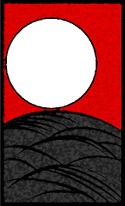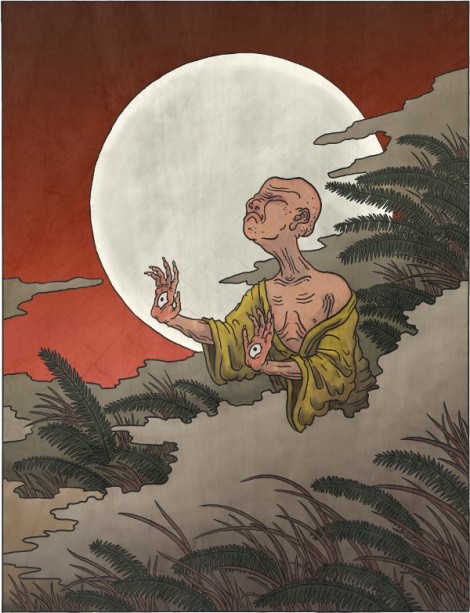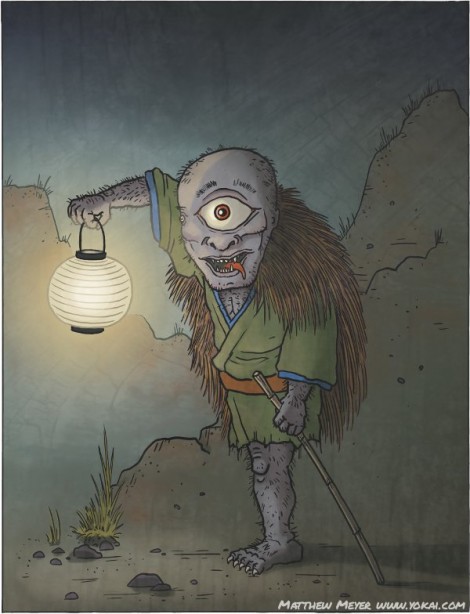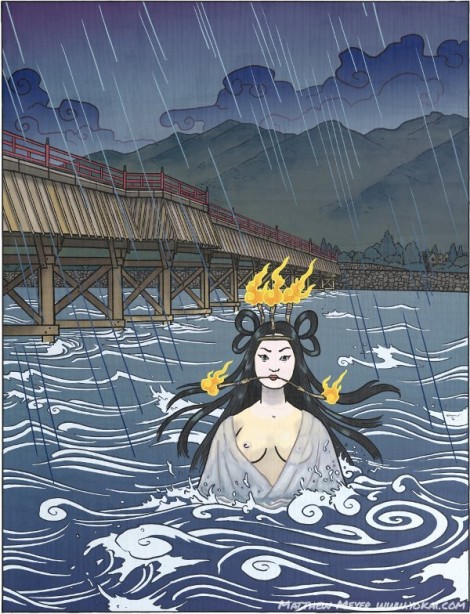One popular request I’ve been getting since Night Parade came out is “more tsukumogami!” For those who do not know, a tsukumogami is a kind of yokai born from common household things. The name means “99-year god,” and the idea is that an object which has been in use for 99 years (or else a very very long time) grows a soul and takes on a life of its own. Also, an item which has long stopped being used may sometimes grow sad or resentful that it is collecting dust in some closet somewhere, and develop a soul of its own.
This folk belief has led to all kinds of neat yokai based on shoes, broken umbrellas, kimonos, broken dishes, dirty kitchen rags, antique instruments, and just about anything else you can think of. They are often silly and cute, and sometimes can be scary too. Today, let’s take a look at a tsukumogami:
Shōgorō (鉦五郎, しょうごろう)
Shōgorō is an animated shōgo (鉦吾), a kind of miniature gong which is used in Buddhist services. If you’ve ever visited a temple in Japan, you have no doubt heard their distinctive ring. They are also sometimes called kane, as we will see later in our story.
A shōgo gets a lot of use, being used multiple times every day. They are made of metal, and so can last a long time. And they belong to temples, so there is a likely chance they will stay with the temple for many years. It is pretty easy to see that shōgo are ideal candidates for turning into tsukumogami. Perhaps a gong has long worn out and stopped playing its note pleasantly, and gets put into storage until it is forgotten… or perhaps one is the witness to some horrible crime, and that awakens it into a yokai.
There is a famous story of a shōgo turning into a shōgorō in Osaka in the early 18th century. Back then, there was a merchant family known as the Yodoya living in Osaka. For many generations, they were the kings of the rice trade, and raked in unbelievable amounts of cash. In fact, the 5th generation boss, Yodoya Tatsugorō, had so much money that his wealth attracted the attention of the bakufu (the regional shogunate officials, something like military police).
The bakufu decided that the Yodoya family had accumulated enough wealth — too much wealth in fact. They were only a merchant family, after all, and it was improper for them to hold so much wealth. It was above their station in life. And so, the bakufu stripped Yodoya Tatsugorō of everything he had: his rice, his business, his house, his every last rich possession. The Yodoya family fell into ruin, and Tatsugorō became destitute. The straw that broke the camels back, so to speak, was the loss of his favorite possession: an unbelievably rich and indescribably splendid golden chicken called Kogane no Niwatori (金の鶏, literally “golden chicken”). The loss of his precious golden chicken caused Tatsugorō so much grief that he died, and because of the unhappy circumstances of his death, his ghost lingered on.
Normally, when a ghost lingers like this, it attaches itself to the object of its desire — whether it be a person, a place, or (in this case) a thing. Tatsugorō’s soul was meant to attach itself to his precious kogane no niwatori. But as I said earlier, a shōgo is also called a kane, and because the words kane 鉦 and kogane 金 can both be written with the kanji for metal, 金, poor Tatsugorō’s ghost must have gotten confused, and it attached itself to a nearby shōgo instead, turning the instrument into an animated yokai.
From that day on, the shōgo was called Shogorō — a kind of portmanteau of shōgo and Tatsugorō. (The name can also be read as a portmanteau of shōgo and goryō, 御霊, which is the ghost of a high social rank or very rich person. Goryō play a large part in other ghost stories, such as the Tale of the Heike and Lafcadio Hearn’s famous Miminashi Hoichi.) Toriyama Sekien really loves his puns and wordplay!

If you liked this yokai, don’t forget to become a supporter of my Kickster project!


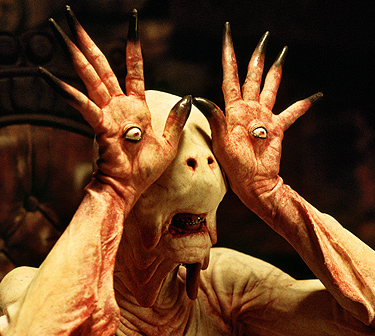
 It doesn’t seem like this yokai became known as te-no-me until Toriyama Sekien dubbed it thusly in his encyclopedia. However, while te-no-me (literally, “eyes on hands”) seems like a painfully obvious name, Sekien had other reasons for attaching this name. They have to deal with Sekien’s unique sense of humor and his love of wordplay, and are rather difficult to translate into English, but let’s see what we can do:
It doesn’t seem like this yokai became known as te-no-me until Toriyama Sekien dubbed it thusly in his encyclopedia. However, while te-no-me (literally, “eyes on hands”) seems like a painfully obvious name, Sekien had other reasons for attaching this name. They have to deal with Sekien’s unique sense of humor and his love of wordplay, and are rather difficult to translate into English, but let’s see what we can do: